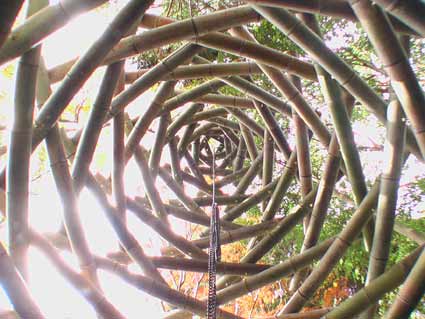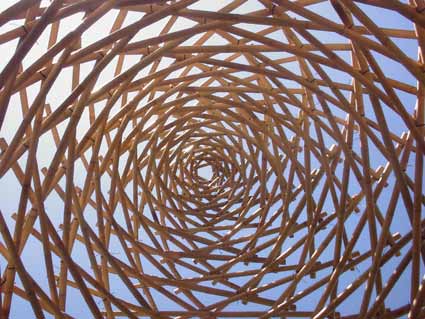
|
JAPAN MEETS SAN FRANCISCO: Wednesday, March 22, 8:00 pm Sponsored by YLEM: Artists Using Science and Technology Contact: Loren Means, lorenmea@pacbell.net, 415-665-5454 |
FROM THE YLEM 2006 NEWS ARCHIVES
YLEM hosts a multimedia event exploring the relationship of mathematics, sculpture, gesture, and sound, featuring Japan’s Akio Hizume in his first visit to the San Francisco Bay Area, and San Francisco’s own Max Mathews, inventor of the Radio Baton electronic music controller.
Akio Hizume is a sculptor, an architect, and a music composer, generating all of his material using the Golden Mean. As he puts it, “I built Mandara on a Rhyzome using a Pentapod Booth whose height was about 180cm tall all over the gallery. This arrangement was based on Penrose Tiling. I hung Bamboo Pleiades Lamps from the top of each booth, and controlled their blinking pattern by computer. The pattern was synchronized with the quasi-periodic back-ground music. The rhythm pattern changed little by little like waves lapping at a beach. It never repeated. In another room, the audience could play an interactive computer-music work called Real Kecak System. Three dimensions are integrated in the common space. These are: 3D (quasi-periodic geometric objects); 2D (quasi-periodic arrangement of the museum); 1D (quasi-periodic background music). These three kinds of designs are the shadow of a six-dimensional structure on lower-dimensional space. We can be aware of 6D geometry only by such a shadow, as Plato said. I have not known of any past example in that architecture has such accord with music as much as in my work. So to speak, I composed a canon of common subjects across several-dimension spaces. The music players play quasi-periodic rhythms on bamboo instruments. The players cannot see the other players. They play according to the air, like grasshoppers, frogs, or cicadas. Each player plays a different but self-similar rhythm. The audience walks around the Medina like free electrons. The Pentapod Booths make a special environment of sound. It is an effect of the Golden Mean, which makes the very matter reflect diffusely.”
AT Bell Labs in 1957, Max Mathews demonstrated synthesis of music on a digital computer with his Music I program. Music I was followed by Music II through Music V and GROOVE, all were involved in the composition and performance of music on and with computers. These programs have been influential in the development of computer music. For this pioneering work he has been called the "father of computer music," and most recently, "the great grandfather of techno!" In 1987 Mathews joined the Stanford University Music Department in the Center for Computer Research in Music and Acoustics (CCRMA) as Professor of Music (Research) where he developed a new pickup for electronic violins and a real-time computer system for music performance called the Conductor and Improv Programs and a 3D MIDI Controller called the Radio Baton. As Max puts it, “Computer performance of music was born in 1957 when an IBM 704 in NYC played a 17 second composition on the Music I program which I wrote. The timbres and notes were not inspiring, but the technical breakthrough is still reverberating. Music I led me to Music II through V. A host of others wrote Music 10, Music 360, Music 15, Csound, Cmix, and SuperCollider. Many exciting pieces are now performed digitally. Recently I have added improvizational options which make it easy to write compositional algorithms. These can involve precomposed sequences, random functions, and live performance gestures. The algorithms are written in the "C" language. We have taught a course in this area to Stanford undergraduates for two years. To our happy surprise, the students liked learning and using "C". Primarily I believe it gives them a feeling of complete power to command the computer to do anything it is capable of doing."
Akio Hizume and Max Mathews will explain and demonstrate their inventions and innovations and answer questions from the audience. This is a rare opportunity to experience these two fecund creative personalities in the festive atmosphere of RX Gallery.
|
JAPAN MEETS BAY AREA AT 21 GRAND Saturday, March 25, 8:00 pm 21 Grand is a non-profit multidisciplinary arts space in downtown Oakland. Suggested donation $10 |
YLEM hosts a multimedia event featuring the noted Japanese musician/sculptor/architect Akio Hizume in his first Bay Area appearance. Joining him will be San Francisco Bay Area musican/performance artists Tim Perkis, John Bischoff, Kenneth Atchley, and Kattt Sammon.
Akio Hizume’s main subjects for research are architecture, the form of music and quasi-periodic geometry based on the Golden Mean. As he puts it, “I do not only research theory but also make many original works practically. I found many quasi-periodic structures. I named them "Star Cage". I built some big Star Cages as geometrical sculptures using bamboo in Japan, Indonesia, Austria, Germany, U.S.A. and Switzerland. My latest discovery is a Self-Standing Star Cage, and people can enter into the center of it. It is almost genuine architecture! I believe they are not only geometry but also avant-garde art. I don't separate science and art. Both of them are human arts. I innovated also musical forms, that is, rhythm, scale and tone. In 1995, I composed a musical piece using the innovations. It was called "Fibonacci Kecak". I published it at an International Congress called ISIS Symmetry in Washington D.C. This music is the same form as my quasi-periodic sculpture completely! I try to bring to fruition of forthcoming architecture and music in the world.”
Tim Perkis has been working in the medium of live electronic and computer sound for many years, performing, exhibiting installation works and recording in North America, Europe and Japan. His work has largely been concerned with exploring the emergence of life-like properties in complex systems of interaction. In addition, he is a well-known performer in the world of improvised music, having performed on his electronic improvisation instruments with over 100 artists and groups. Ongoing groups he has founded or played in include the League of Automatic Music Composers and the Hub -- pioneering live computer network bands.
John Bischoff is an early pioneer of live computer music. He is known for his solo constructions in real-time synthesis as well as his ground-breaking work in computer network bands. Bischoff's music is built from intrinsic features of the electronic medium: high definition noise components, tonal edges, imperfections, transitions, digital shading, and non-linear motion. Through empirical play and investigation he builds pieces that can be described as sonic sculptures, shaped in real-time and present for the duration of a performance. In 1999 he received a $25,000 award from the Foundation for Contemporary Performance Arts (NYC) in recognition of his music.
Kenneth Atchley is a sound, video, and installation artist who fashions and performs works ranging from pure-tone and noise hymns to distortion-studded, electro-acoustic devotionals. His work has long focused on creating platforms that allow an absorbed, immersive attention. Much of his work has included the use of fountains as sound-sources, objects, and environments and his current presentations continue to be informed by and abstract that work and study. A profile of his work was included in the June, 2005 issue of The Wire (#256) and will be featured in Tim Perkis' film Noisy People (in production).
Kattt Sammon writes, composes, sings, reads text, plays keyboard, and mixes these disciplines into performance. Ms. Sammon's works include solo performance, as well as, collaborations with artist Kenneth Atchley; and since 2003 has commissioned musical theater pieces from a growing roster of artists who include Judy Dunaway, Blue Gene Tyranny, Alyssa Lee and Kunsu Shim. In 2005, the text and stage diagram for her piece "Talking Trash" was published in the anthology "Sound Visions". She continues studies in classical piano with Brian Reinbolt and singing with Molly Holm. Ms. Sammon has performed at venues in the Bay Area, New York, and Germany.
Be sure to join us for this historic meeting of Akio Hizume in his first Bay Area visit, and these outstanding Bay Area artists!

